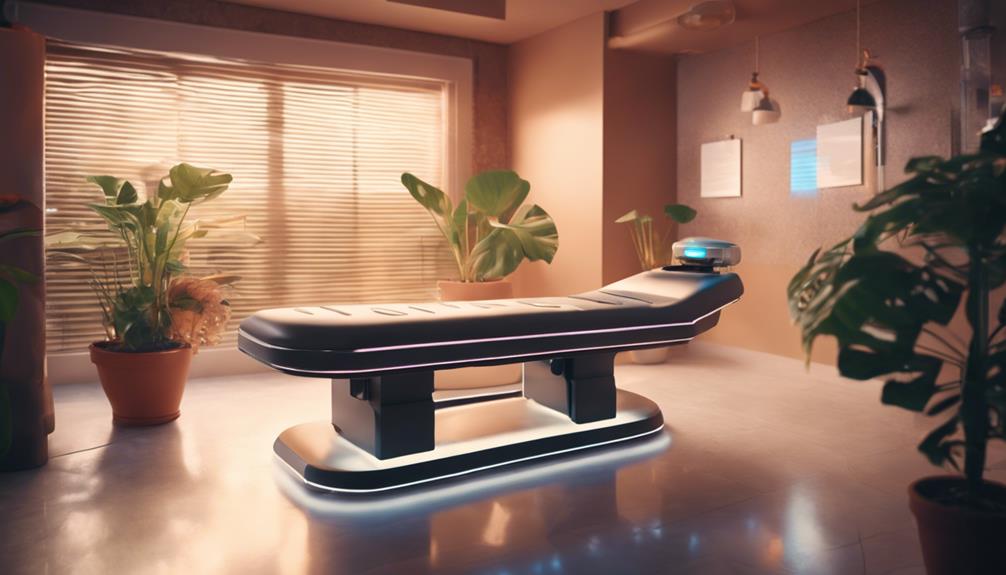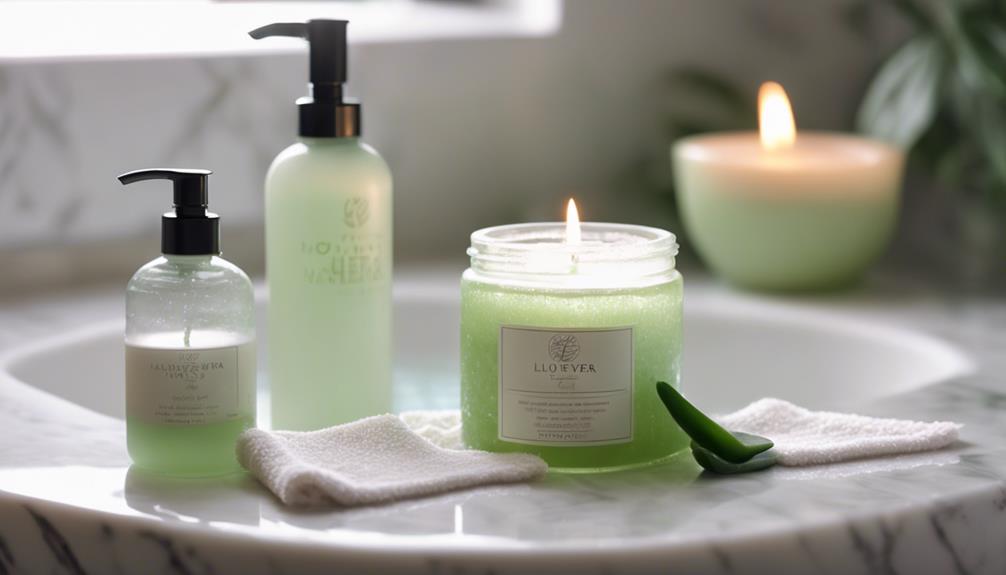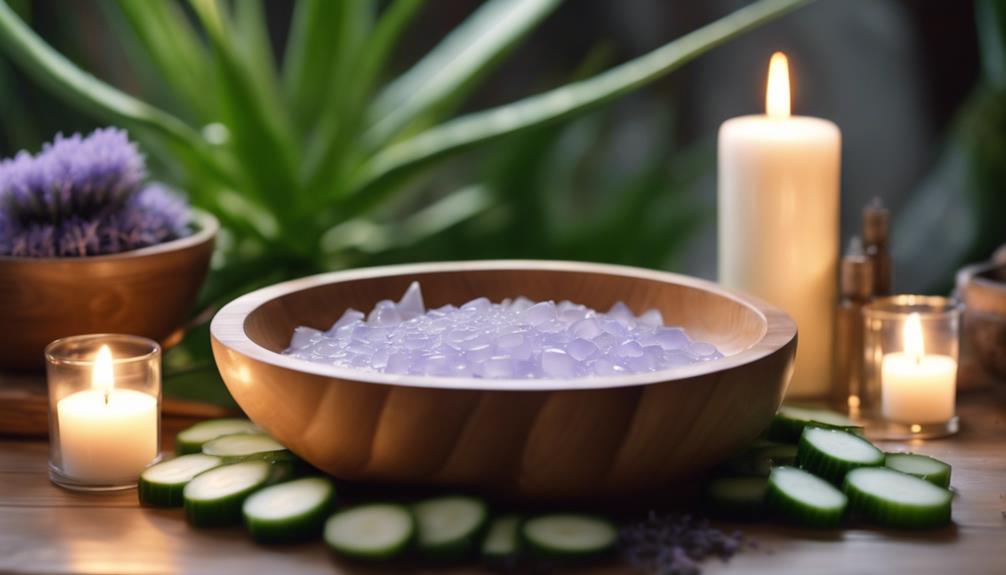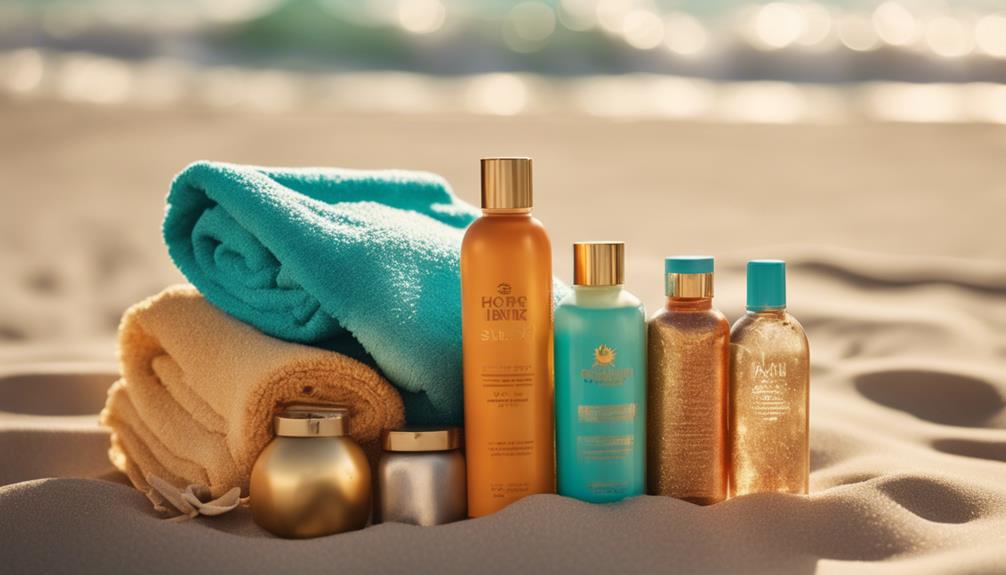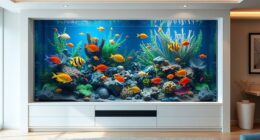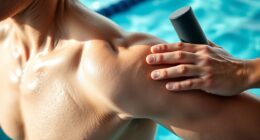Maintaining cleanliness in tanning salons is crucial for your health and safety. When selecting a salon, it is important to choose one that follows strict cleaning protocols. Regular disinfection of tanning beds and thorough weekly cleaning can help minimize the risk of skin infections. Staff should uphold high standards of hygiene by frequently washing their hands and using protective equipment. Technologies such as UV-C sanitization and disposable bed covers can further enhance safety. A hygienic environment not only improves your overall experience but also ensures your comfort during tanning sessions. There is much more to learn about establishing a secure tanning regimen that you should consider exploring!
Key Takeaways
- Cleanliness in tanning salons prevents skin infections and promotes overall health and safety for clients during their tanning sessions.
- Daily disinfection of tanning beds with effective products, like Australian Gold pH neutral disinfectant, is crucial for maintaining hygiene.
- Implementing strict cleaning protocols and using checklists ensures consistency in salon cleanliness and creates a welcoming atmosphere for clients.
- Staff hygiene standards, including handwashing and PPE usage, are essential in promoting a culture of safety and cleanliness in the salon.
Importance of Cleanliness
Cleanliness in tanning salons isn't just about appearance; it directly impacts your health and safety during tanning sessions. When you step into a tanning bed, you want to know that it's been properly sanitized. A clean environment reduces the risk of skin infections and other health issues.
Germs can thrive on surfaces, especially in a salon setting, so it's essential for staff to adhere to strict cleaning protocols. By ensuring that tanning beds and common areas are regularly disinfected, you're protecting not only yourself but also other clients.
Plus, a clean salon creates a more inviting atmosphere, allowing you to relax and enjoy your tanning experience. Prioritizing cleanliness helps everyone feel safe and comfortable during their visit.
Daily Cleaning Protocols
Every day, you should begin by thoroughly disinfecting the tanning beds with Australian Gold pH neutral disinfectant to secure a safe environment for your clients.
After spraying, confirm the disinfectant's effectiveness using quat test strips.
Next, polish the acrylic surfaces with Novus #1 for a shiny finish, and use Novus #2 to address any scratches.
Don't forget to clean all surfaces in your salon to create a welcoming atmosphere.
This daily routine not only enhances client comfort but also maintains high hygiene standards.
Ascertain you have a checklist to stay consistent with these protocols.
Weekly Deep-Clean Procedures

To maintain a high standard of hygiene, perform an extensive deep-clean of tanning beds and salon surfaces each week using Australian Gold pH neutral disinfectant cleaner.
Start by removing any items from the tanning beds and wiping down all surfaces.
Spray the disinfectant thoroughly, ensuring every inch is covered, and let it sit for the recommended contact time.
Use quat test strips to confirm the disinfectant's effectiveness.
Don't forget to focus on other salon surfaces, like countertops and door handles, to provide a clean environment for your clients.
After cleaning, inspect the tanning beds for any damages or needed repairs.
This weekly routine not only elevates your salon's cleanliness but also enhances the overall client experience.
Client Safety Measures
Ensuring client safety during tanning sessions is essential for a positive experience and healthy skin. By following these precautions, you can minimize risks and enjoy your tanning sessions more confidently:
- Protective Eyewear: Always wear protective goggles to shield your eyes from harmful UV rays. This step is vital for preventing eye damage.
- Disclosure of Medications: Inform your tanning technician about any medications or skin conditions you're currently dealing with. Certain medications can increase your sensitivity to UV light.
- Hydration: Keep your skin hydrated before and after tanning. Using a moisturizer will help maintain your skin's health and improve the overall tanning results.
Tanning Session Best Practices

How can you maximize your tanning results?
First, shower before your session to cleanse your skin and enhance absorption.
Make certain you wear protective eyewear to safeguard your eyes during tanning.
Stick to recommended exposure times to prevent overexposure and skin damage.
It's also wise to limit your sessions to once or twice a week for peak results without risking your skin's health.
After tanning, rinse off to maintain freshness and avoid breakouts.
Don't forget to hydrate your skin before and after tanning with a good moisturizer.
Finally, always disclose any medications or skin conditions to guarantee a safe experience.
Following these best practices helps you achieve that beautiful, bronzed glow while prioritizing your skin's health.
Staff Hygiene Standards
Maintaining high staff hygiene standards is essential for providing a safe and comfortable tanning experience for clients. You need to guarantee that your team follows strict hygiene protocols to build trust and promote a healthy environment.
Here are three key practices to implement:
- Handwashing: Staff should wash their hands thoroughly before and after each client interaction, using soap and water for at least 20 seconds.
- Personal Protective Equipment (PPE): Make certain your staff wears gloves and aprons to minimize germ transfer during sessions.
- Cleaning Protocols: Require team members to clean tanning beds and surrounding areas after each use, guaranteeing every surface is wiped down appropriately.
Innovations in Tanning Hygiene

Building on the importance of staff hygiene standards, innovations in tanning hygiene are introducing new methods and products that enhance cleanliness and client safety in tanning salons.
Advanced UV-C sanitization systems now automatically disinfect tanning beds between sessions, guaranteeing a germ-free environment.
Additionally, disposable tanning bed covers provide a fresh, clean surface for each client, minimizing cross-contamination.
You'll also find touchless cleaning sprays that eliminate the need for physical contact, further reducing the risk of germ transfer.
Incorporating these innovations not only improves hygiene but also boosts client confidence in your salon.
Frequently Asked Questions
How Often Should Clients Check Their Tanning Bed for Cleanliness?
You should check your tanning bed for cleanliness before each use. Look for any visible dirt or residue, and verify the staff has properly cleaned it after the last client to guarantee a safe tanning experience.
Can I Bring My Own Disinfectant to the Salon?
While it's tempting to bring your own disinfectant for peace of mind, most salons prefer using their approved products. Trust their protocols; they're designed to keep you safe and enhance your tanning experience.
What Should I Do if I Notice a Cleanliness Issue?
If you notice a cleanliness issue, don't hesitate to inform the staff immediately. They'll appreciate your feedback and address the problem promptly, ensuring a clean and safe environment for all clients. Your comfort matters!
Are There Any Specific Cleaning Products That Should Be Avoided?
When cleaning, avoid harsh chemicals that could damage surfaces or irritate skin. Picture the sheen of polished acrylic, and remember, gentle products like pH neutral disinfectants maintain that shine while ensuring a safe, inviting environment for everyone.
How Can I Provide Feedback About the Salon's Cleanliness?
You can provide feedback about the salon's cleanliness by speaking directly to the staff or management. You might also consider leaving a review online to share your experience and suggestions for improvement.
Why is cleanliness important in tanning salons?
Maintaining cleanliness in tanning salons is crucial to elevate tanning hygiene experience. Regular cleaning of tanning beds, floors, and equipment helps prevent the spread of bacteria and viruses. A clean environment also promotes a better tanning experience for customers, making them feel more comfortable and safe.
How Important is Cleanliness in Tanning Salons?
Cleanliness in tanning salons is crucial for the safety and comfort of customers. Following tanning hygiene tips helps prevent the spread of germs and maintain a clean environment. Regular cleaning of tanning beds, equipment, and facilities is essential to promote a healthy and enjoyable tanning experience.
How Important is Cleanliness in a Tanning Salon Setting?
Maintaining cleanliness in a tanning salon setting is crucial to ensure a safe and pleasant experience for customers. Clean surfaces, sanitized equipment, and proper hygiene practices can elevate your tanning hygiene standards and prevent the spread of germs or infections. A clean environment also promotes customer confidence and loyalty.
Conclusion
You might think maintaining a clean tanning salon is a hassle, but it's actually the key to an enjoyable experience.
A spotless environment not only boosts your confidence but also protects your health.
By prioritizing cleanliness, you're ensuring that every visit is safe and relaxing.
So, next time you step in, you can fully unwind, knowing that hygiene is exceptional.
Embrace these practices, and you'll see how a clean salon transforms your tanning sessions into something truly fabulous!


